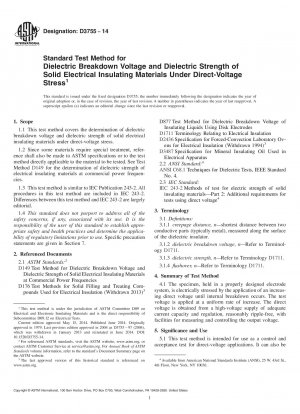ASTM D3755-14
Standard Test Method for Dielectric Breakdown Voltage and Dielectric Strength of Solid Electrical Insulating Materials Under Direct-Voltage Stress
- Standard No.
- ASTM D3755-14
- Release Date
- 2014
- Published By
- American Society for Testing and Materials (ASTM)
- Status
- Replace By
- ASTM D3755-20
- Latest
- ASTM D3755-20
- Scope
5.1 This test method is intended for use as a control and acceptance test for direct-voltage applications. It can also be used in the partial evaluation of material for specific end uses and as a means for detecting changes in material due to specific deteriorating causes.
5.2 Experience indicates that the breakdown value obtained with direct voltage usually will be approximately 2 to 4 times the rms value of the 60-Hz alternating-voltage breakdown.
5.3 For a nonhomogeneous test specimen, the distribution of voltage stress within the specimen is determined by impedance (largely capacitive) with alternating voltage. With an increasing direct voltage, the voltage distribution will still be largely capacitive, although this depends partly on the rate of voltage increase. After steady application of direct voltage the voltage division across the test specimen is determined by resistance. The choice of direct or alternating voltage depends upon the purpose for which the breakdown test is to be used, and to some extent, on the intended application of the material.
5.4 A more complete discussion of the significance of dielectric breakdown tests is given in Appendix X1 of this method and in Appendix X1 of Test Method D149. Those appendix sections of Test Method D149 that refer to alternating voltage are not applicable to the direct-voltage method.
1.1 This test method covers the determination of dielectric breakdown voltage and dielectric strength of solid electrical insulating materials under direct-voltage stress.
1.2 Since some materials require special treatment, reference shall also be made to ASTM specifications or to the test method directly applicable to the material to be tested. See Test Method D149 for the determination of dielectric strength of electrical insulating materials at commercial power frequencies.
1.3 This test method is similar to IEC Publication 243-2. All procedures in this test method are included in IEC 243-2. Differences between this test method and IEC 243-2 are largely editorial.
1.4 This standard does not purport to address all of the safety concerns, if any, associated with its use. It is the responsibility of the user of this standard to establish appropriate safety and health practices and determine the applicability of regulatory limitations prior to use. Specific precaution statements are given in Section 7.
ASTM D3755-14 Referenced Document
- ASTM D149 Standard Test Method for Dielectric Breakdown Voltage and Dielectric Strength of Solid Electrical Insulating Materials at Commercial Power Frequencies
- ASTM D1711 Standard Terminology Relating to Electrical Insulation
- ASTM D176 Standard Test Methods for Solid Filling and Treating Compounds Used for Electrical Insulation
- ASTM D3487 Standard Specification for Mineral Insulating Oil Used in Electrical Apparatus
- ASTM D877 Standard Test Method for Dielectric Breakdown Voltage of Insulating Liquids Using Disk Electrodes
ASTM D3755-14 history
- 2020 ASTM D3755-20 Standard Test Method for Dielectric Breakdown Voltage and Dielectric Strength of Solid Electrical Insulating Materials Under Direct-Voltage Stress
- 2014 ASTM D3755-14 Standard Test Method for Dielectric Breakdown Voltage and Dielectric Strength of Solid Electrical Insulating Materials Under Direct-Voltage Stress
- 1997 ASTM D3755-97(2004) Standard Test Method for Dielectric Breakdown Voltage and Dielectric Strength of Solid Electrical Insulating Materials Under Direct-Voltage Stress
- 1997 ASTM D3755-97 Standard Test Method for Dielectric Breakdown Voltage and Dielectric Strength of Solid Electrical Insulating Materials Under Direct-Voltage Stress
